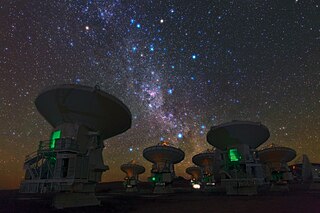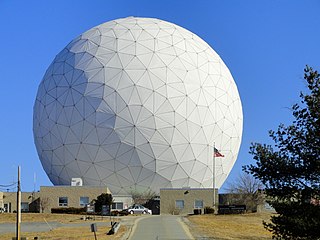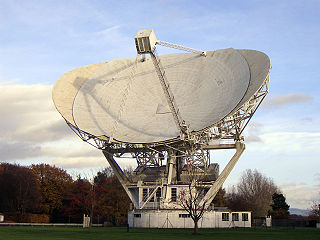
A radio telescope is a specialized antenna and radio receiver used to receive radio waves from astronomical radio sources in the sky. Radio telescopes are the main observing instrument used in radio astronomy, which studies the radio frequency portion of the electromagnetic spectrum emitted by astronomical objects, just as optical telescopes are the main observing instrument used in traditional optical astronomy which studies the light wave portion of the spectrum coming from astronomical objects. Radio telescopes are typically large parabolic ("dish") antennas similar to those employed in tracking and communicating with satellites and space probes. They may be used singly or linked together electronically in an array. Unlike optical telescopes, radio telescopes can be used in the daytime as well as at night. Since astronomical radio sources such as planets, stars, nebulas and galaxies are very far away, the radio waves coming from them are extremely weak, so radio telescopes require very large antennas to collect enough radio energy to study them, and extremely sensitive receiving equipment. Radio observatories are preferentially located far from major centers of population to avoid electromagnetic interference (EMI) from radio, television, radar, motor vehicles, and other man-made electronic devices.

Radio astronomy is a subfield of astronomy that studies celestial objects at radio frequencies. The first detection of radio waves from an astronomical object was in 1932, when Karl Jansky at Bell Telephone Laboratories observed radiation coming from the Milky Way. Subsequent observations have identified a number of different sources of radio emission. These include stars and galaxies, as well as entirely new classes of objects, such as radio galaxies, quasars, pulsars, and masers. The discovery of the cosmic microwave background radiation, regarded as evidence for the Big Bang theory, was made through radio astronomy.

Very-long-baseline interferometry (VLBI) is a type of astronomical interferometry used in radio astronomy. In VLBI a signal from an astronomical radio source, such as a quasar, is collected at multiple radio telescopes on Earth. The distance between the radio telescopes is then calculated using the time difference between the arrivals of the radio signal at different telescopes. This allows observations of an object that are made simultaneously by many radio telescopes to be combined, emulating a telescope with a size equal to the maximum separation between the telescopes.

The Karl G. Jansky Very Large Array (VLA) is a centimeter-wavelength radio astronomy observatory located in central New Mexico on the Plains of San Agustin, between the towns of Magdalena and Datil, ~50 miles (64 km) west of Socorro. The VLA comprises twenty-eight 25-meter radio telescopes deployed in a Y-shaped array and all the equipment, instrumentation, and computing power to function as an interferometer. Each of the massive telescopes is mounted on double parallel railroad tracks, so the radius and density of the array can be transformed to adjust the balance between its angular resolution and its surface brightness sensitivity. Astronomers using the VLA have made key observations of black holes and protoplanetary disks around young stars, discovered magnetic filaments and traced complex gas motions at the Milky Way's center, probed the Universe's cosmological parameters, and provided new knowledge about the physical mechanisms that produce radio emission.

The Very Long Baseline Array (VLBA) is a system of ten radio telescopes which are operated remotely from their Array Operations Center located in Socorro, New Mexico, as a part of the Long Baseline Observatory (LBO). These ten radio antennas work together as an array that forms the longest system in the world that uses very long baseline interferometry. The longest baseline available in this interferometer is about 8,611 kilometres (5,351 mi).

The Lovell Telescope is a radio telescope at Jodrell Bank Observatory, near Goostrey, Cheshire in the north-west of England. When construction was finished in 1957, the telescope was the largest steerable dish radio telescope in the world at 76.2 m (250 ft) in diameter; it is now the third-largest, after the Green Bank telescope in West Virginia, United States, and the Effelsberg telescope in Germany. It was originally known as the "250 ft telescope" or the Radio Telescope at Jodrell Bank, before becoming the Mark I telescope around 1961 when future telescopes were being discussed. It was renamed to the Lovell Telescope in 1987 after Sir Bernard Lovell, and became a Grade I listed building in 1988. The telescope forms part of the MERLIN and European VLBI Network arrays of radio telescopes.
The Joint Institute for VLBI ERIC (JIVE) was formed in 1993 by the European Consortium for VLBI, and since then, it is the central facility of the European VLBI Network (EVN). In 2015, JIVE became a European Research Infrastructure Consortium. Very Long Baseline Interferometry (VLBI) is a type of astronomical interferometry used in radio astronomy. It allows observations of an object that are made simultaneously by many telescopes to be combined, emulating a telescope with a size equal to the maximum separation between the telescopes. Normally the participating radio telescopes function individually, working on their own specific projects. In the case of VLBI, they all observe the same source at the same time, allowing much higher spatial resolution. There are many complex and challenging hurdles that need to be overcome to enable this effort. One challenge is the data processing requirement. JIVE operates the "EVN Data Processor" - a special-purpose supercomputer for astronomical VLBI data correlation. In a recent demonstration of JIVE 14 telescopes from in Australia, Chile, China, Finland, Germany, Italy, the Netherlands, Poland, Puerto Rico, Spain, Sweden and the UK participated in joint observations of the active galaxy 3C120. The participating telescopes included:

The 22-metre Mopra Radio Telescope, located near Coonabarabran, New South Wales, is part of the Australia Telescope National Facility, operated by CSIRO. The name hails from the location of the facility close to Mopra Rock a geological formation overlooking the telescope. It is also close to the Siding Spring optical observatory in the Warrumbungle National Park.

The Mount Pleasant Radio Observatory is a radio astronomy based observatory owned and operated by University of Tasmania, located 20 km east of Hobart in Cambridge, Tasmania. It is home to three radio astronomy antennas and the Grote Reber Museum.

Haystack Observatory is an astronomical observatory owned by Massachusetts Institute of Technology (MIT). It is located in Westford, Massachusetts (US), approximately 45 kilometers (28 mi) northwest of Boston. Haystack was initially built by MIT's Lincoln Laboratory for the United States Air Force and was known as Haystack Microwave Research Facility. Construction began in 1960, and the antenna began operating in 1964. In 1970 the facility was transferred to MIT, which then formed the Northeast Radio Observatory Corporation (NEROC) with a number of other universities to operate the site as the Haystack Observatory. As of January 2012, a total of nine institutions participated in NEROC.

The Hartebeesthoek Radio Astronomy Observatory (HartRAO) is a radio astronomy observatory, located in a natural bowl of hills at Hartebeesthoek just south of the Magaliesberg mountain range, Gauteng, South Africa, about 50 km west of Johannesburg. It is a National Research Facility run by South Africa's National Research Foundation. HartRAO was the only major radio astronomy observatory in Africa until the construction of the KAT-7 test bed for the future MeerKAT array.

An astronomical interferometer is an array of separate telescopes, mirror segments, or radio telescope antennas that work together as a single telescope to provide higher resolution images of astronomical objects such as stars, nebulas and galaxies by means of interferometry. The advantage of this technique is that it can theoretically produce images with the angular resolution of a huge telescope with an aperture equal to the separation between the component telescopes. The main drawback is that it does not collect as much light as the complete instrument's mirror. Thus it is mainly useful for fine resolution of more luminous astronomical objects, such as close binary stars. Another drawback is that the maximum angular size of a detectable emission source is limited by the minimum gap between detectors in the collector array.

The Dominion Radio Astrophysical Observatory is a research facility founded in 1960 and located at Kaleden, British Columbia, Canada. The site houses four radio telescopes: an interferometric radio telescope, a 26-m single-dish antenna, a solar flux monitor, and the Canadian Hydrogen Intensity Mapping Experiment (CHIME) — as well as support engineering laboratories. The DRAO is operated by the Herzberg Institute of Astrophysics of the National Research Council of the Government of Canada. The observatory was named an IEEE Milestone for first radio astronomical observations using VLBI.

The Algonquin Radio Observatory (ARO) is a radio observatory located in Algonquin Provincial Park in Ontario, Canada. It opened in 1959 in order to host a number of the National Research Council of Canada's (NRC) ongoing experiments in a more radio-quiet location than Ottawa.

The Mark II is a radio telescope located at Jodrell Bank Observatory, near Goostrey, Cheshire, in the north-west of England. It was built on the site of the 218 ft (66.4 m) Transit Telescope. Construction was completed in 1964. The telescope's design was used as the basis of the 60 ft (18 m) Goonhilly 1 telescope, and the Mark III telescope is also based on a similar design.

The Metsähovi Radio Observatory is an astronomical observatory in Finland, affiliated with the Aalto University. Its main premises are in Metsähovi, Kirkkonummi, 35 kilometers west of the university's Otaniemi campus.
Arthur Edwin Covington was a Canadian physicist who made the first radio astronomy measurements in Canada. Through these he made the valuable discovery that sunspots generate large amounts of microwaves at the 10.7 cm wavelength, offering a simple all-weather method to measure and predict sunspot activity, and their associated effects on communications. The sunspot detection program has run continuously to this day.

MeerKAT, originally the Karoo Array Telescope, is a radio telescope consisting of 64 antennas in the Northern Cape of South Africa. In 2003, South Africa submitted an expression of interest to host the Square Kilometre Array (SKA) Radio Telescope in Africa, and the locally designed and built MeerKAT was incorporated into the first phase of the SKA.

The Large Latin American Millimeter Array (LLAMA) is a single-dish 12 m Nasmyth optics antenna which is under construction in the Puna de Atacama desert in the Province of Salta, Argentina. The primary mirror accuracy will allow observation from 40 GHz up to 900 GHz. It is also planned to install a bolometer camera at millimeter wavelengths. After installation it will be able to join other similar instruments to perform Very Large Base Line Interferometry or to work in standalone mode. Financial support is provided by the Argentinian and Brazilian governments. The total cost of construction, around US$20 million, and operation as well as the telescope time use will be shared equally by the two countries. Construction planning started in July 2014 after the formal signature of an agreement between the main institutions involved.

The Korean VLBI Network (KVN) is a radio astronomy observatory located in South Korea. It comprises three 21-meter radio telescopes that function as an interferometer, using the technique of very-long-baseline interferometry (VLBI).



















